Recent Articles
Popular Makes
Body Types
2024 Ford F-150 Lightning Road Test and Review
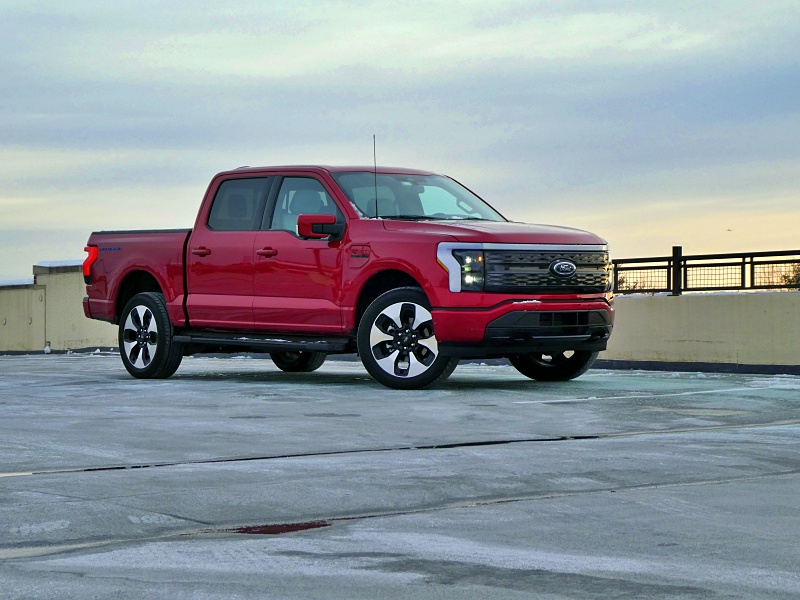
2023 Ford F-150 Lightning Platinum ・ Photo by Brady Holt
Most of the hottest electric pickup trucks are electric first, pickups second. It's almost like a memo went around that electric pickups had to look different. Tesla got everyone started with its robot-warrior Cybertruck. The Rivian R1T has the rounded-off cheerfulness of an eMac computer. The GMC Hummer can "crab-walk." The upcoming Chevrolet Silverado and GMC Sierra EV are sleek quasi-unibody vehicles rather than boxy body-on-frame trucks.
The 2024 Ford F-150 Lightning shrugs off all that. It’s pretty much a regular-looking pickup truck with electric motors instead of a gasoline engine. It beat nearly all competitors to the market, hitting the streets nearly two years ago, and it was last year’s best seller. For this review, we spent a week testing the F-150 Lightning to learn more about the advantages and disadvantages of an electric pickup – and whether Ford has created a solution that could work for you. Keep reading to find what we learned.
Prices That Move Around
When it debuted for 2022, the F-150 Lightning made headlines for its starting price of just under $40,000. That didn’t last long. The 2023 model jumped all the way to $55,974 for a base vinyl-upholstered Pro model, then was cut back to $49,995. Now, for 2024, it’s back up to $54,995 – at least as we write in February 2024. The consumer-grade XLT, meanwhile, starts at $64,995. A new trim level called the Flash pairs the model’s bigger battery with technology features like a big touchscreen, hands-free driving, and a premium stereo for $73,495. These trim levels qualify for a $7,500 federal tax credit, now available at the point of sale, for customers who meet income restrictions and other requirements.
Other models cost more. The leather-trimmed Lariat starts at $79,495 while the extra-luxe Platinum like our test vehicle starts at $84,995. Those fully optioned models do cost less than they did in 2023, while Ford also provided more standard equipment. But we’re talking about a luxury vehicle, not a simple work truck. Still, as we’ll discuss on the coming pages, these prices can still be reasonable for the right buyer.
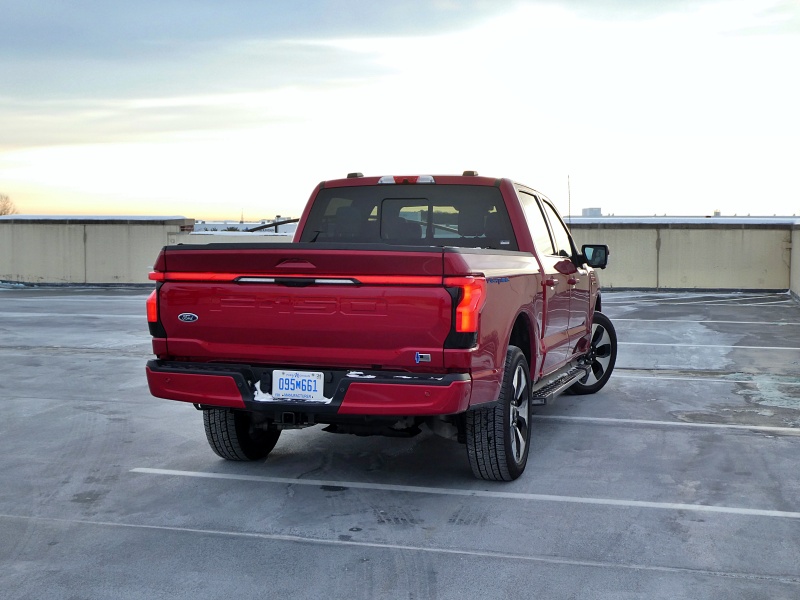
2023 Ford F-150 Lightning Platinum ・ Photo by Brady Holt
Up to 320 Miles per Charge
With its standard battery pack, included on the Pro and XLT, the 2024 Ford F-150 Lightning travels an EPA-estimated 240 miles per charge while averaging the equivalent of 76 mpg in the city, 61 mpg on the highway, and 68 mpg combined. The extended-range battery pack on other trim levels improves the truck’s range to 320 miles on the Flash and Lariat (300 miles on the heavier Platinum), and efficiency is up by 2 MPGe as well. Towing a large trailer or hauling a heavy payload cuts sharply into those range estimates, and it goes farther in stop-and-go conditions than highway driving. However, one notable EV advantage is that they use little energy to idle. Also, while prices for gasoline and electricity will vary by region, the Lightning’s average fuel costs are typically around half that of the typical gas-powered F-150.
It takes about 12 hours to fully charge the F-150 Lightning using a 240-volt car charger, like you’d install at home or find in many public stations. That means you’d return to full range by plugging in overnight. A public fast-charger can bring it from 15 percent to 80 percent charge in as little as 36 minutes. And even if you don’t find any car chargers, you can get about 2 miles of range per hour at any standard three-prong outlet.
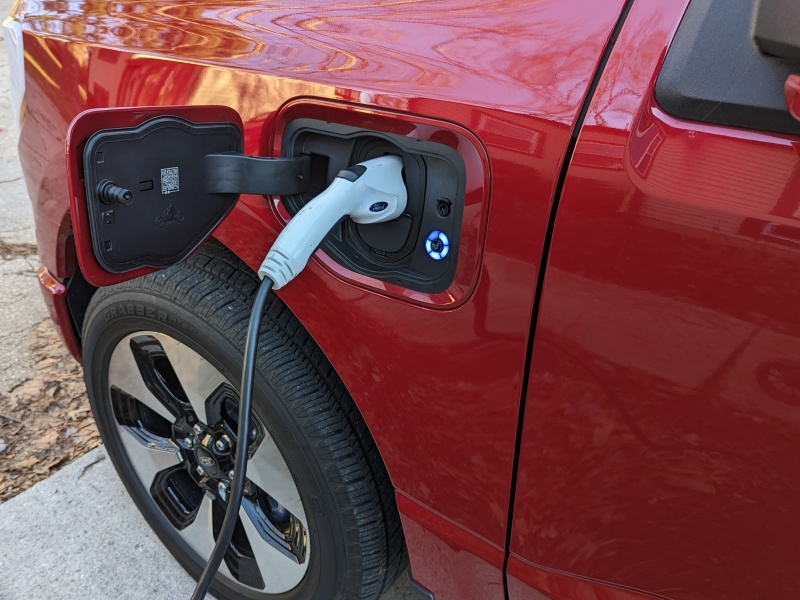
2023 Ford F-150 Lightning Platinum ・ Photo by Brady Holt
Driving in the Cold
Electric vehicles infamously lose range in cold weather. When we started up a fully charged F-150 Lightning Platinum in subfreezing conditions, it wavered between an estimated range of 285 and 273 miles (versus the 300-mile EPA estimate). We drove 103.5 miles, largely on the highway, and it reported 115 miles of range remaining – a combined total of 228.5 miles, or 76 percent of the EPA range. That total also includes charge lost while the truck was parked. And recall that the F-150 Lightning is less efficient on the highway. So that’s not a bad showing in our book. What’s more, the 2024 Lightning now includes a heat pump (missing from our 2023-model test vehicle) that should help further in cold conditions.
Still, cold weather clearly took its toll. We last tested an F-150 Lightning in a warm September. We drove 147.2 miles in this 2022-model truck, equivalently equipped to the 2024 Flash, and it still estimated 202 miles of range remaining – for a total of nearly 350 miles. It also averaged 2.8 miles per kilowatt-hour (94 MPGe) versus 1.7 miles/kWh for our winter-tested Platinum (57 MPGe). Either mileage figure, of course, is incredible for a big pickup – especially considering that the F-150 Lightning is also incredibly fast.

2023 Ford F-150 Lightning Platinum ・ Photo by Brady Holt
Speedy and Silent
The F-150 Lightning comes standard with two electric motors: one for the front wheels and one for the rear wheels. Torque is a mighty 775 lb-ft, while horsepower ranges from 452 with the standard battery pack to 580 with the extended range.
Like most EVs, the Lightning delivers smooth, nearly silent, and incredibly swift acceleration. Even sports cars are exciting when they reach 60 mph in just 4 seconds. It’s an even more absurd experience to do so in a full-size pickup truck, especially without the accompanying roar of a big engine. When you crunch the numbers on the F-150 Lightning, remember that you’re not just paying for efficiency — you’re also upgrading to the fastest F-150 on the market. And if that’s not a priority to you, don’t worry; the F-150 Lightning is also easy to drive normally. Just keep pushing farther and farther down on the throttle for wilder and wilder speed.
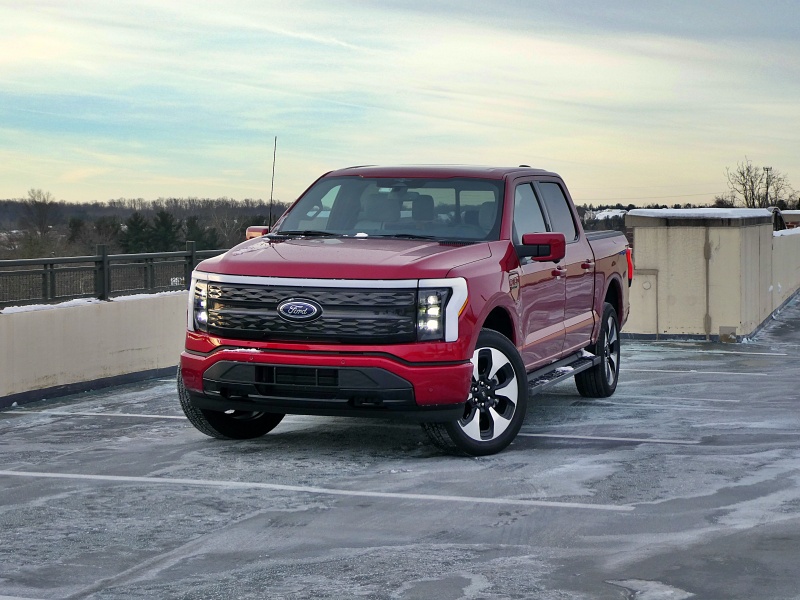
2023 Ford F-150 Lightning Platinum ・ Photo by Brady Holt
Better Ride and Handling, Too
It’s an old trope that full-size pickups have gotten better and better to drive, but sometimes that gets exaggerated. They still tend to have jiggly rides and clumsy handling by most standards. The F-150 Lightning is a rare exception.
While this is still a body-on-frame truck, it replaces the gas F-150’s solid rear axle with an independent rear suspension. This change improves both the ride quality and the handling. So does the electric battery, which is heavy and low in the vehicle, providing a planted feel and a low center of gravity. Especially when paired with its smooth acceleration and lack of engine noise, the F-150 Lightning is an uncommonly sophisticated pickup to drive. And if you don’t want to drive it yourself, Ford’s BlueCruise system is now standard on all but the Pro and XLT trim levels. It uses cameras and other sensors to operate the vehicle on 130,000 miles of pre-mapped highways across North America. Unlike most rival systems (the exception being General Motors’ Super Cruise), Ford explicitly allows you to drive hands-free. It’ll disengage if road conditions become too challenging, you leave a pre-mapped route, or the in-car camera senses that you’re not watching the road. We only wish it clearly announced doing so; we’d sometimes glance down to see that the truck had handed control back to us without our notice.
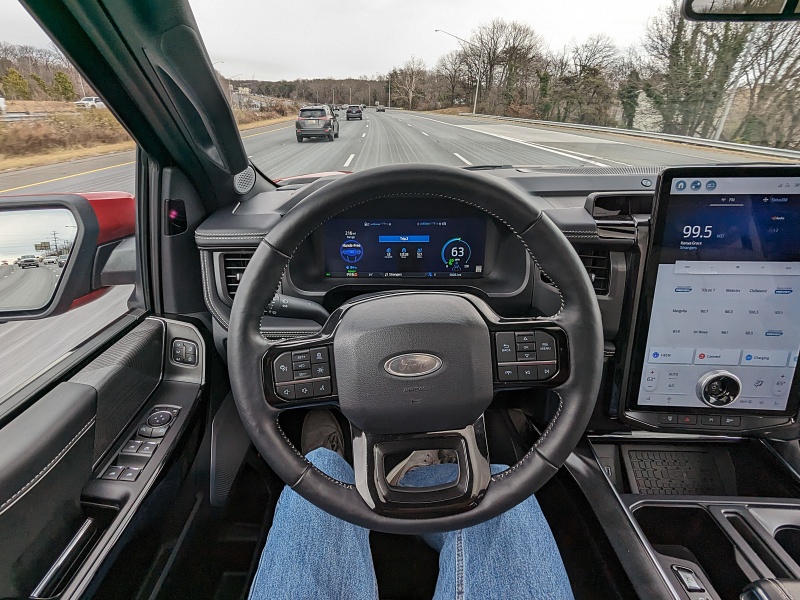
2023 Ford F-150 Lightning Platinum ・ Photo by Brady Holt
Capable in Its Own Way
As we mentioned, towing and hauling cuts sharply into an EV’s range. The F-150 Lightning probably isn’t the truck for you to haul your boat or camper trailer across the country. However, it’s capable in other valuable ways.
For shorter jaunts, the Lightning Pro and XLT can tow up to 7,700 pounds, while trims with the larger battery can hit 10,000. Payload capacity ranges from about 1,600 to 2,200 pounds. Those are solid numbers for a half-ton crew-cab pickup. What’s more, the Lightning has some unique EV-specific benefits as well. Its front trunk (or “frunk”) provides 14.1 cubic feet of dry, secure cargo room under the hood; that’s about the same as a sedan’s trunk. And you can use the Lightning’s battery as a portable generator — powering your tools at a job site, lighting your house during a power outage, or even recharging another EV. Note that while the gas F-150 has a wide range of body styles, every Lightning is a four-door crew cab with four-wheel drive and a 5.5-foot-long bed.
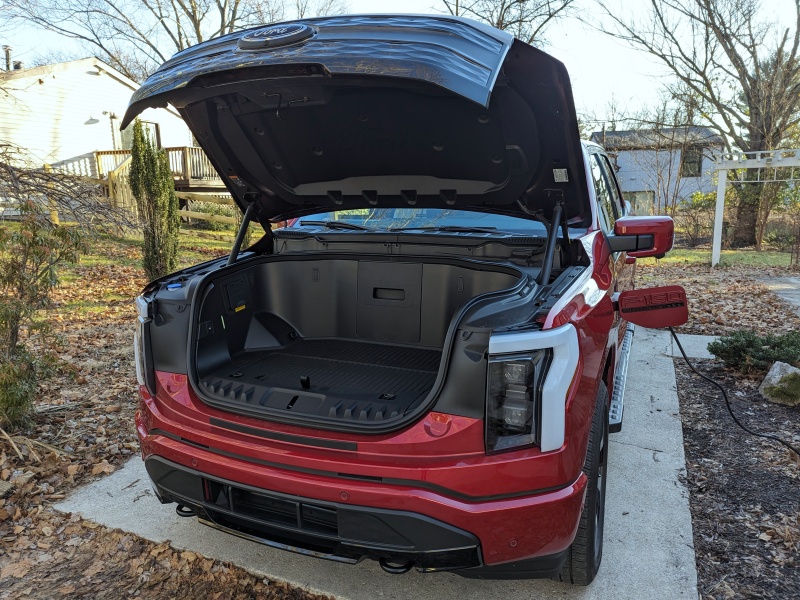
2023 Ford F-150 Lightning Platinum ・ Photo by Brady Holt
Familiar F-150 Design
For the most part, the F-150 Lightning shares its body and exterior with the gas F-150. Ford dresses up the exterior with front and rear lightbars on most trim levels, and the grille and wheels are a bit different. But this isn’t an EV that screams “car of the future.”
It’s a little flashier inside, where most trim levels now use a big 15.5-inch vertically arranged touchscreen versus the gas F-150’s 12-inch horizontal screen. (We appreciate the smaller screen’s useful buttons and knobs, and you can also get this layout on the F-150 Lightning Pro and XLT.) But whichever Lightning you choose, you still get a physical PRNDL gear selector on the console, and the gauge cluster (while digital) sits behind a round steering wheel. Instead of facial recognition to unlock the car if you forget your key, you can punch a code into a keypad panel like it’s 1982. And an old-school mast antenna pops out of the hood to get the best possible radio reception. This isn’t a flashy luxury car, but if you like regular trucks, the F-150 Lightning holds onto that everyday functionality.
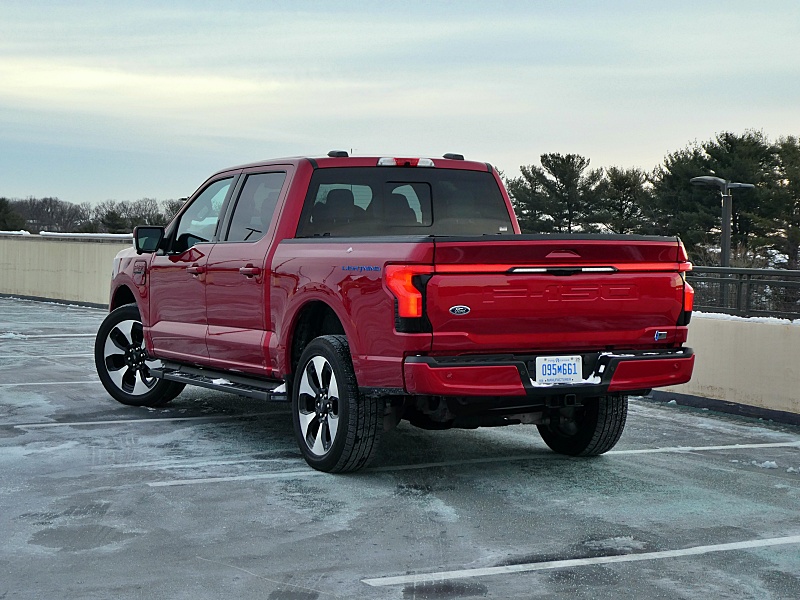
2023 Ford F-150 Lightning Platinum ・ Photo by Brady Holt
Cushy Seats
If you haven’t been inside a big pickup lately, you might not appreciate one of the reasons they’re so popular: huge, comfortable seats. And that’s exactly what you get from the F-150, including the Lightning. The dashboard may be more workmanlike than most expensive EVs, or even some rival pickups, but this truck is undeniably cushy. We loved its well-padded chairs and ample space to spread out in both the front and rear.
We also got to use our F-150 Lightning as a mobile office. In a feature shared with the gas model, the Lightning lets you fold down the gear selector and convert the center console into a workstation table. Throw in the in-car Wi-Fi and EVs’ ability to idle without quickly draining the battery or stinking up the neighborhood, and it’s a great place to open up your laptop from wherever you’re parked.
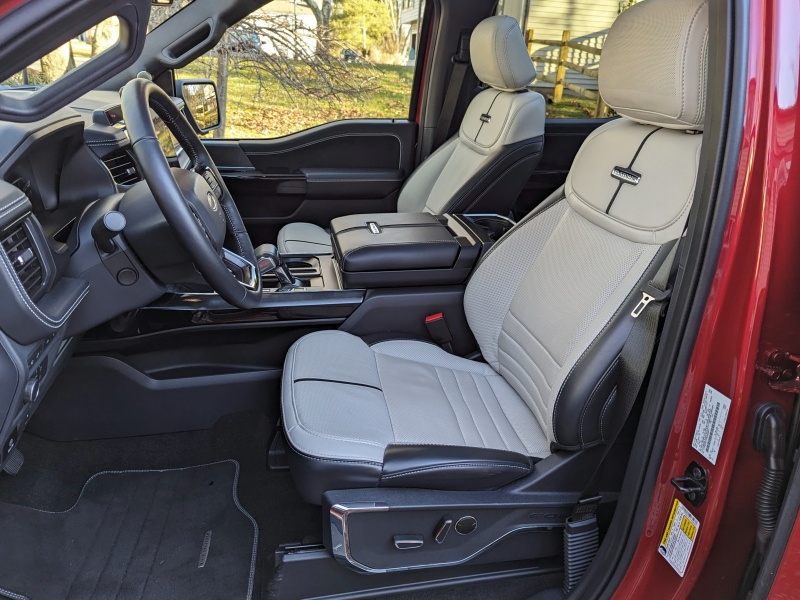
2023 Ford F-150 Platinum ・ Photo by Brady Holt
F-150 Lightning vs. the Competition
Right behind the F-150 Lightning as the best-selling EV pickup is the Rivian R1T, which was the first electric pickup to the market. It’s more playful in its design and functionality, taking full advantage of its ground-up EV status to offer things like a storage tunnel between the cabin and bed. It also has a longer range (up to 358 miles depending on the trim level) and nimbler handling. But it’s smaller and more expensive than the F-150 Lightning, more of a luxury lifestyle vehicle than an electrified everyday truck.
The Tesla Cybertruck also commands huge attention in the market. The waitlist remains long, but early committers are now getting their triangle-shaped trucks. It costs $79,900 for a base all-wheel-drive model and $20,000 more for the ultra-performance Cyberbeast. (A $60,000 rear-drive Cybertruck is available to order but won’t enter production until at least 2025.) The AWD Cybertruck matches the F-150 Lightning in performance and doesn’t cost much more given its extra standard features, and its 340-mile range estimate edges out the Ford’s. The Tesla can also out-tow the F-150 with a promised 11,000-pound capacity. But the bigger difference is the vibe: The F-150 Lightning is a functional, businesslike electric pickup, and the Cybertruck is a wild-looking attention-grabber. The same applies to the GMC Hummer EV, though it’s even more expensive and also less efficient. Closer competitors are on the way in the future from Ford’s crosstown rivals of Chevy and Ram, but we don’t expect to see them in dealers for nearly another year.
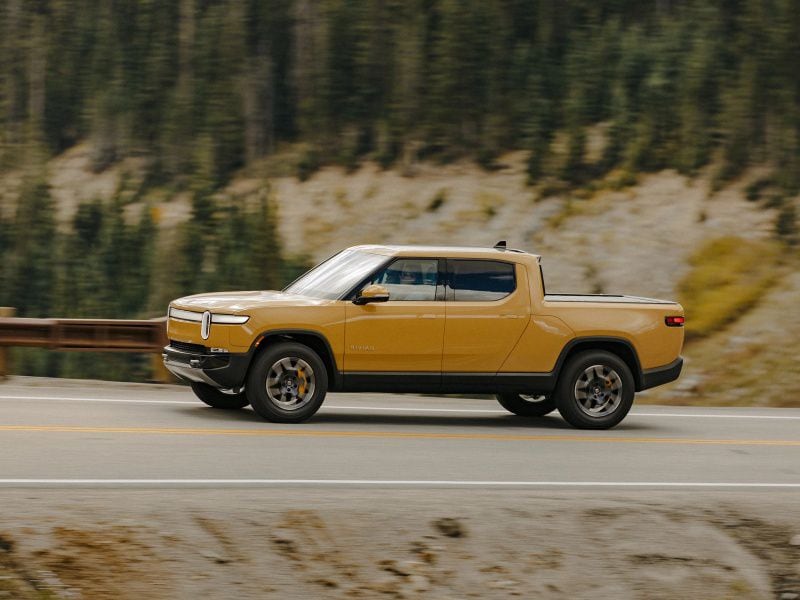
2022 Rivian R1T ・ Photo by Rivian
The Meeting of Present and Future
An EV isn’t for every truck owner. It needs time to charge and a place to charge it. And it won’t work well with long-distance drives, especially with a trailer attached.
But there’s still a lot to like for the right buyer. The F-150 Lightning not only cuts your tailpipe emissions and fuel bills, but it’s also a performance truck with sports-car acceleration and uncommonly sophisticated handling. And unlike many EVs, it doesn’t go overboard with gimmicky quirks like bizarre control layouts or fussy door handles. If you like a regular F-150, odds are you’d like this one even more, as long as you can make it work for your life. It’s not cheap, but its lower operating costs will help it pay for itself, and the superior driving experience is worth its own premium. Overall, with its power, efficiency, and smart features, the F-150 Lightning advances the traditional pickup truck in many ways without making things too weird or difficult. If you'd like to cut out gas and don’t often drive much more than 200 miles (or tow a big trailer more than, say, 75 miles) in a single day, it’ll fit easily into your life. For longer drives, you’ll have to decide if the F-150 Lightning’s superlative driving manners are worth the time and bother of stopping to recharge along the way.
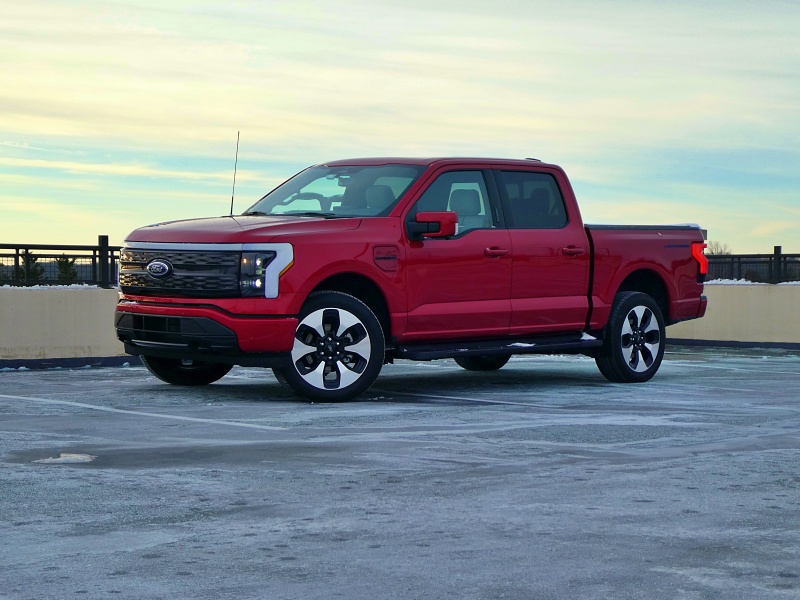
2023 Ford F-150 Lightning Platinum ・ Photo by Brady Holt